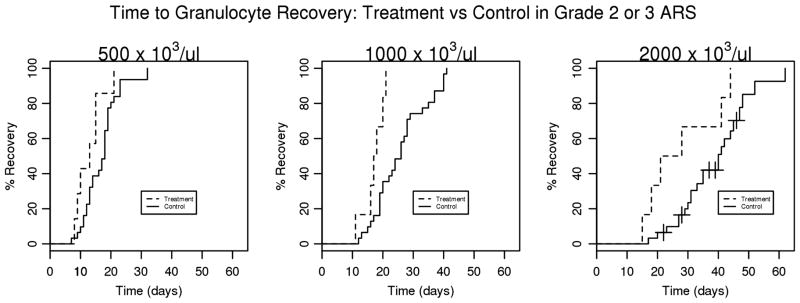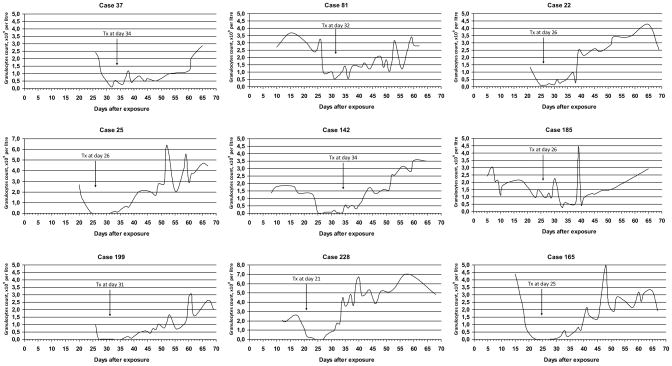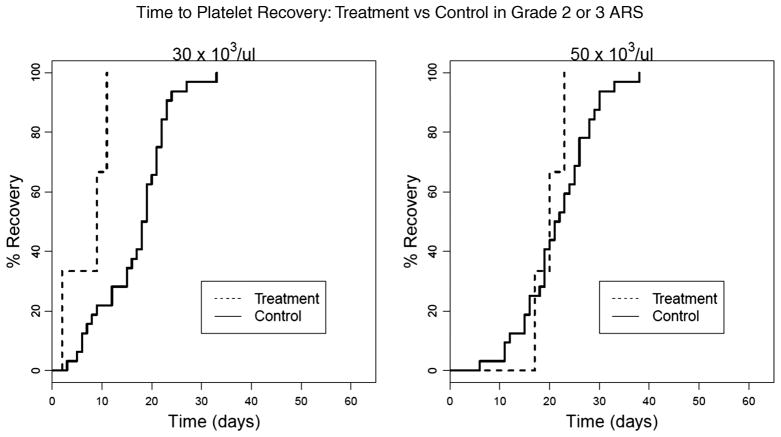Abstract
Purpose
To present previously unavailable data on the use of stem cell administration to aid recovery of victims of the Chernobyl disaster. On 26 April 1986, an accident at Unit 4 of the Chernobyl Nuclear Power Plant took place during the planned test of one of the safety systems. The diagnosis of acute radiation syndrome (ARS) was confirmed in 134 individuals exposed to high levels of radiation. There were nine patients heretofore unreported in the scientific literature who underwent intraosseous injections of allogeneic bone marrow cells in Kyiv.
Conclusions
Transplantation was associated with significantly shortened time to recovery of granulocyte and platelet counts in these patients. While current guidelines would certainly include the use of cytokines, these data provide an indication of the effectiveness of stem cell transplant to treat victims of radiation exposure.
Keywords: Chernobyl disaster, stem cell transplantation, cellular therapy, emergency response
Background
Developing rational strategies to treat acute radiation syndrome (ARS) resulting from a large scale radiological or nuclear event remains challenging. One of the hallmarks of ARS is bone marrow suppression, but conventional transplantation protocols would be logistically prohibitive when dealing with hundreds or thousands of patients simultaneously. Alternative approaches are needed, but there are few clinical experiences to draw upon for guidance. Despite the fact that more than 400 radiologic accidents have occurred since 1944, resulting in more than 3000 victims with significant absorbed doses, there is limited experience with the use of hematopoietic cell transplantation in accidentally exposed humans (Dainiak and Ricks 2005). We present newly available data which supports the use of exogenous stem cells in these patients.
On 26 April 1986, an accident at Unit 4 of the Chernobyl Nuclear Power Plant took place during the planned test of one of the safety systems (International Atomic Energy Association [IAEA] 1986). The diagnosis of acute radiation syndrome (ARS) was confirmed in 134 individuals exposed to high levels of radiation (IAEA 2002), the majority of which were treated in Moscow (Guskova et al. 1988, Baranov et al. 1989). Victims with ARS were randomly sent to Moscow and in the evening of 27 April, the then General Secretary Gorbachev announced on national news that all the victims had been transported to Moscow. In reality, 25 patients with confirmed diagnosis were left behind and were treated for ARS in hospitals in Kyiv. Among them, there were nine patients heretofore unreported in the scientific literature who underwent intraosseous injections of allogeneic bone marrow cells.
Methods
The data were not collected as part of a prospective research study. Given the emergency nature of the situation, patients were only consented for the medical procedures performed as was the standard for that time. The data presented comply with our current institutional standards for anonymised research. Donor cells which were partially or fully matched for human leukocyte antigen (HLA) HLA-A and HLA-B loci were obtained from either cyropreserved bone marrow aspirates (seven patients) or freshly collected from donors (two patients). The cryopreserved cells were obtained from a repository of bone marrow aspirates at the Institute of Hematology and Transfusiology, Kyiv, Ukraine. This bank was established in 1976 and at the time of the incident had approximately 200 specimens which were HLA-typed prior to storage. All donors were unrelated and compatible for the blood group antigens ABO and Rh.
Aspirates were injected in the ossailiacae of nine ARS patients immediately after collection or thawing in the case of the cryopreserved specimens. Patients were selected on the treating physicians’ assessment of the need for transplantation and the availability of matched donor cells. The median interval from exposure to transplantation was 26 days (range 21–34). The median number of transplanted viable nucleated bone marrow cells was 3.06 × 109 (range 1.64–8.7 × 109). There was no target donor cell dose selected a priori, and in most cases all available donor cells were used.
A control group consisting of 59 Chernobyl patients who had a diagnosis of ARS, but who did not receive stem cell transplants was used for statistical comparison. The treatment and control groups did not differ in terms of supportive care, which included co-trimoxazole and nystatin, antibiotics and blood products if needed. No prophylaxis for graft-versus-host disease was provided for the patients of the treatment group.
The impact of the stem cell transplants was assessed by a comparison of rate of granulocyte recovery in treatment and control groups (Figure 2). The time-to-recovery (the gap time) distribution for each stratum was estimated using the Kaplan-Meier estimator. The discrepancy between the time-to-recovery distributions was tested using the Cox score test. Cases for which recovery above the level of interest was not observed were censored at the time of the last visit under the implicit assumption that the censoring is not informative. Another implicit assumption is that the two event times are independent. Those cases for which cell counts were not available were dropped from the analysis. Given the small sample size, we also approximated the null sampling distribution using B=10,000 permutation replicates under the implicit assumption that the censoring distribution does not depend on the stratum. The results presented were not adjusted for multiple testing.
Figure 2.
Time to granulocyte recovery profiles for grade 2 or 3 ARS patients who received allogeneic bone marrow transplantation versus non-transplanted patients. Time-to-recovery above 500 × 103/μl level, following decrease below this level, was used as the primary clinical endpoint. The day of recovery was defined as the first of three consecutive days on which blood granulocytes rose to 500 × 103/μl (P-value < 0.066). Time-to-recovery to 1000 and 2000 × 103/μl levels (P-values < 0.001 and < 0.022, respectively) were also considered.
Results
Details of patients’ demographics, HLA matching, ARS grade and estimated absorbed dose of radiation are presented in Table I. Granulocyte counts for the individual patients relative to the time of transplantation are shown in Figure 1. The median time to recovery above 500 × 103/μl in transplanted grade 2/3 ARS patients was 13 days vs. 18 days in the control group (asymptotic P-value < 0.066) (Figure 2). The median time to reach levels of 1000 × 103/μl was 17.5 days in the treatment group and 26.0 days in the control group (asymptotic P-value < 0.001). The median time to 2000 × 103/μl was 24.5 days in grade 2/3 ARS the treatment group and 40.0 days in the control group (asymptotic P-value < 0.022). The corresponding permutation P-values were 0.089, 0.0040 and 0.032, respectively. Platelet recovery was also assessed for grade 2 or 3 ARS patients who received allogeneic bone marrow transplantation versus non-transplanted patients (Figure 3). Time-to-recovery above 30 × 103/μl platelets, following decrease below this level, was used as the primary clinical endpoint. The day of recovery was defined as the first of three consecutive days on which platelets rose to 30 × 103/μl. The median time to recovery above 30 × 103/μl in transplanted grade 2/3 ARS patients was nine days vs. 18 days in the control group (asymptotic P-value < 0.0023) (Figure 2). Time-to-recovery to 50 × 103/μl levels was also assessed but no significant differences were detected (P-values < 0.34).
Table I.
Data are presented on ARS patient demographics, estimated dose of radiation, clinical grade of ARS, and blood typing. Donor Summary of available information NA – not assessed.
| Recipient
|
Donor
|
Procedure details
|
||||||||||||
|---|---|---|---|---|---|---|---|---|---|---|---|---|---|---|
| ID | Sex/age | ARS grade | Dose, Gy | ABO | Rh | HLA | ABO | Rh | HLA | Processing of aspirate before procedure | Days from exposure to transplantation | Volume of injected aspirate, ml | Number of injected mononuclear cells (MNC), × 109 | Viability, in % of injected MNC |
| 37 | F/47 | 1 | 1.2 | 0 | positive | A2,10;B5,7 | 0 | positive | A2,10;B5,7 | fresh | 34 | no data | 6.0 | 95 |
| 81 | M/31 | 1 | 0.8 | 0 | positive | A10,28;B8 | 0 | positive | A10,28;B22 | stored 1 month | 32 | no data | 2.0 | 82 |
| 22 | M/46 | 2 | 2.1 | A | positive | A3,19;B13,21 | A | positive | A3;B27,40 | stored 2 years | 26 | 70 | 6.0 | 88 |
| 25 | M/21 | 2 | NA | 0 | positive | A2,11;B13 | 0 | positive | A2,11;B7,13 | stored 3 years | 26 | 70 | 2.6 | 82 |
| 142 | F/63 | 2 | NA | B | positive | A2;B7,13 | B | positive | A2,10;B13,17 | stored 1 month | 34 | 200 | 3.4 | 86 |
| 185 | M/35 | 2 | NA | A | positive | A3,9;B7,8 | A | positive | A3,28;B7 | fresh | 26 | 200 | 8.0 | 95 |
| 199 | M/25 | 2 | 1.7 | A | positive | A1,10;B5,40 | A | positive | A1,2;B5,13 | stored 7 years | 31 | 90 | 3.4 | 90 |
| 228 | M/79 | 2 | 2.5 | A | positive | A11;B7,40 | A | positive | A1,11;B13,21 | stored 1 year | 21 | 40 | 2.0 | 85 |
| 165 | M/23 | 3 | NA | A | positive | A2,10;B27 | A | positive | A2,10;B7,27 | stored 10 years | 25 | 98 | 10.0 | 87 |
Figure 1.
The individual profiles of granulocyte counts of patients who received bone marrow transplants. The dates of transplantation are shown by arrows as Tx.
Figure 3.
Time to platelet recovery profiles for grade 2 or 3 ARS patients who received allogeneic bone marrow transplantation versus non-transplanted patients. Time-to-recovery above 30 × 103/μl platelets level, following decrease below this level, was used as the primary clinical endpoint. The day of recovery was defined as the first of three consecutive days on which platelets rose to 30 × 103/μl (P-value < 0.0023). Time-to-recovery to 50 × 103/μl platelets was also measured but was not significantly different in the two groups (P-values < 0.34).
Discussion
The role of stem cell therapy for treatment of nuclear disaster victims remains controversial with only limited experience and data on which to base recommendations. The data presented do not demonstrate a clear direct effect and current treatment guidelines indicate the use of cytokine therapy in addition aggressive supportive therapy and possibly stem cell transplant to treat victims of radiation exposure incidents. However, this study supports the assumption that through bridging to endogenous hematopoiesis recovery, allogeneic stem cell support might be a useful strategy for ARS patients.
Acknowledgments
We thank all physicians and staff who have cared for ARS patients in 1986, and especially Prof. Viktor Klymenko, Prof. Mikola Bondar, Prof. Leonid Kindzelskyi, Prof. Georgiy Kogut, Prof. Galina Gluchenkaja, and their co-workers, who arranged and performed the transplant procedures in Kyiv.
Footnotes
Declaration of interest: The authors report no conflicts of interest. The authors alone are responsible for the content and writing of the paper. Supported by NIH U19 AI 067798.
References
- Baranov A, Gale RP, Guskova A, Piatkin E, Selidovkin G, Muravyova L, Champlin RE, Danilova N, Yevseeva L, Petrosyan L. Bone marrow transplantation after the Chernobyl nuclear accident. New England Journal of Medicine. 1989;321:205–212. doi: 10.1056/NEJM198907273210401. [DOI] [PubMed] [Google Scholar]
- Dainiak N, Ricks RC. The evolving role of haematopoietic cell transplantation in radiation injury: Potentials and limitations. British Journal of Radiology Supplement. 2005;27:169–174. [Google Scholar]
- Guskova A, Barabanova A, Baranov A, Gruszdev G, Pyatkin Y, Nadezhina N, Metlyaeva N, Selidovkin G, Moiseev A, Gusef I, Dorofeeva E, Zykova I. Sources effects and risks of ionizing radiation. New York: United Nations; 1988. Acute radiation effects in victims of the Chernobyl accident. [Google Scholar]
- International Atomic Energy Agency (IAEA) Summary report on the post-accident review meeting on the Chernobyl accident: Report. Vienna: IAEA; 1986. [Google Scholar]
- International Atomic Energy Agency (IAEA) Follow-up of delayed health consequences of acute accidental radiation exposure lessons to be learned from their medical management. Vienna: IAEA; 2002. [Google Scholar]





